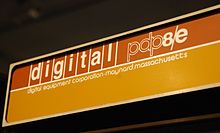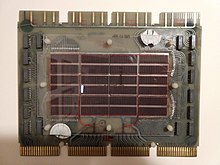PDP-8/e
 | |
 PDP-8/e at the Living Computer Museum in Seattle, Washington | |
| Manufacturer | Digital Equipment Corporation |
|---|---|
| Product family | PDP-8 |
| Generation | 6th Generation |
| Release date | 1970 |
| Introductory price | $6,500 |
| Operating system | OS/8 |




The PDP-8/e was a model of the PDP-8 line of minicomputers, designed by the Digital Equipment Corporation to be a general purpose computer that inexpensively met the needs of the average user while also being capable of modular expansion to meet the more specific needs of advanced user.[1]
Description[edit]
The first prototype was built in 1970, and was among the first minicomputers small enough to fit in the back seat of a Volkswagen Beetle Convertible.[2] It originally sold for $6,500 but after 18 months the price was dropped to $4995 to make it the only computer under $5000 available at that time.[3]
The standard -8/e included a processor, core memory, a data terminal, a tape control and drive, a programmers table, a line printer, software operating system and when purchased included installation, training and maintenance as part of the purchase agreement.[4]
The PDP-8/e featured a processor with single-address fixed word length, parallel transfer computer using 12-bit, two's complement arithmetic. The 1.2/1.4 microsecond cycle time provides a computation rate of 385,000 additions per second. It was built to be versatile and has a high capacity input/output that supports more than 60 types of peripherals.[1] It could be used for a variety of tasks, from keeping score at Fenway Park to monitoring stimuli to the brain during brain surgery at Massachusetts General Hospital.[5]
Basic system[edit]
The basic PDP-8/E system was a 10.5 x 19 x 24 inch [6] (6 rack unit) rackmount or table top unit that contained the processor, core memory, front panel controls ("programmer's console"), console terminal interface for use with an external data terminal, and 115 or 230 volt AC power supply.[7]
Peripherals[edit]
Processor options[edit]
- Extended Arithmetic Element - Enables the performance of complex arithmetic at high speeds
- FPP-12 Floating Point Processor - Provides a dual-processor capability for faster calculations
- Power Fail and Automatic Restart - Restores operation automatically after a power failure and protects the operating program
- Real-Time Clocks - Programmable, line frequency, or crystal controlled intervals
- MI8-E hardware bootstrap, an array of diodes allowing startup without manually toggling in the bootstrap via the front panel
Mass storage devices[edit]
- DECtape magnetic tape drives
- RX01 8 inch floppy disk drives (256kB)
- RK05 hard drive with removable cartridge (2.5 Mb). Left rack in photo
- Paper Tape Readers and Punches - Punches up to 50 characters a second, reads up to 300 characters per second
- Card Readers - Marked or punched cards read at 300 cards per minute
Display devices[edit]
- Video and Writing Tablets - Alphanumeric and graphic display point-plot displays; light pens; telephone line transmission
- Hard-Copy Devices - incremental plotters; line printers with 64- or 96-characters sets, 165 characters per second or 356 lines per minute
Data communications devices[edit]
- Synchronous Communications - Modem interface for Bell 201- and 300-series modems or equivalent
- Asynchronous Communications - Serial-line interface at various send/receive Baud rates; single or double buffered interfaces\
- Automatic Calling Units - 10-Channel multiplexer
Laboratory devices[edit]
- Analog to Digital Converters
- Digital to Analog Converters
- Programmable Real-Time Clock
- Digital I/O
- Heathkit EU-801E Laboratory I/O buffered interface, provided a 12-bit wide data port to the PDP-8. Used by David Larsen (Virginia Tech) in his course to instruct researchers in interfacing minicomputers[8]
Terminals[edit]
- CRT and Data-Entry Terminals - Alphanumeric 16-character keyboards; standard telephone line transmission
- Teletype Terminals - send and receive only; synchronous read and punch
- Hard-Copy Terminals - Serial or parallel interfaces
References[edit]
- ^ a b Digital Equipment Corporation (1971). PDP-8/E : Small Computer Handbook. University of California: Digital Equipment Corporation. pp. 2–1.
- ^ "Exhibits - Living Computer Museum". www.livingcomputermuseum.org. Archived from the original on 2016-02-05. Retrieved 2016-07-05.
- ^ "PDP-8/E and PDP-8/M Computer Information". www.pdp8.net. Retrieved 5 July 2016.
- ^ Newest Members of the Worlds most Popular Minicomputer Family. Maynard, Massachusetts: Digital Equipment Corporation. 1973.
- ^ "DEC's Blockbuster: The PDP-8 - CHM Revolution". www.computerhistory.org.
- ^ "PDP-8/E and PDP-8/M Computer Information". pdp8.net. Retrieved 2018-08-22.
- ^ PDP-8/E PDP-8/M & PDP-8/F Small Computer Handbook. Digital Equipment Corporation. 1973. p. 2-1, 2-3. Retrieved 2018-08-22.
- ^ David Larson (September 18, 2015). "PDP-8 Minicomputer Interfacing - How to connect your PDP-8 to the outside world 1972".
